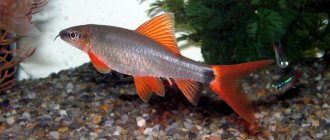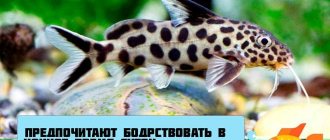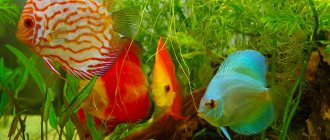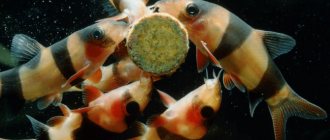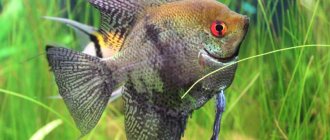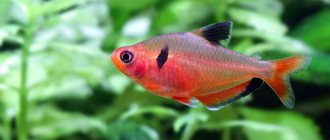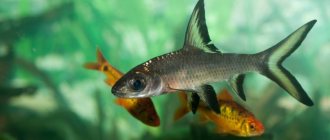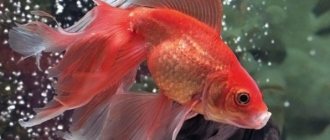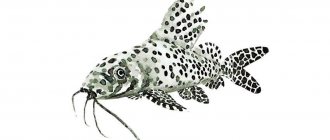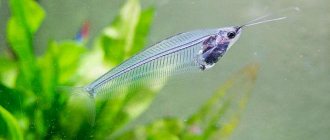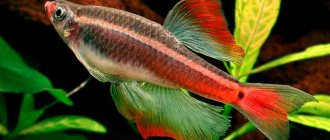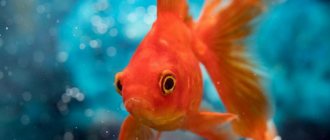Tetras and their structural features, as well as differences in gender
As already mentioned, tetra fish are not large. Their body length is only 3-4 cm. The color is brownish or olive, with a white belly. The fins are colored red. Between the head and back there are two dark stripes. Male tetras are more brightly colored than females. Their difference (males) is the presence of a black stripe running along the edge of the anal and ventral fins. The female's tail is pink, while the male's is almost colorless.
What diseases threaten
This species is not only unpretentious, it is also distinguished by strong immunity and excellent adaptive capabilities. But with an illiterate diet, poor conditions, and poor-quality water, glass tetras can get sick. Their owners should be wary of the following symptoms:
If such signs, unusual for a healthy fish, occur, it is necessary to double-check the indicators of the aquatic environment and consult with specialists. Often, for glass tetras to recover, simple adjustments to their living conditions and diet are not enough, but full treatment is necessary, which depends on the identified pathology:
| Disease | Signs of defeat | Treatment |
| Dropsy (ascites) | the fish swells, the size of the abdomen increases significantly | antibiotic drugs are used (Bicillin 5, Sera-Baktopur-Direct, Maracyn, potassium permanganate) the contents of the capsule are mixed with food |
| Bug-eyed | visual organs increase in size | the culprit of the disease is bad water, the aquarium is completely cleaned and disinfected, the water is changed every 2-3 days until the symptoms disappear |
| Plistophorosis | loss of appetite, change in body color, lethargy and apathy | the disease is incurable, the affected individual is caught, the aquarium tank, equipment and decorations with soil are disinfected |
| Fin rot | spots appear on the fins of a sick fish, ulcers and a specific coating form | the affected areas are treated with a penicillin solution; for disinfection, sea salt and a weak manganese solution are added to the aquarium water over the next 2 weeks |
| Hexamitosis | parasitic infection, tetra changes color, ulcers appear on the body | treatment is carried out with antibacterial agents in combination with antiseptic solutions |
Glass tetras have a naturally strong immune system. Their treatment is successful and quick in most cases. It is necessary to treat the fish in a separate container, removing them from the general aquarium.
The glass tetra is an unusual fish, distinguished by its original color, bright individuality in behavior and an interesting, playful disposition. A big advantage is their unpretentiousness, ease of care, excellent immunity and omnivorousness. With the right approach, unusual aquarium pets will delight their owner for a long time.
What do tetras look like?
All representatives of the species are characterized by:
- Small size. There are “kids” with a body length of 2.5 cm and 15-centimeter “giants”.
- A narrow long body, shaped like a diamond.
- A rich palette of colors, which is determined by the variety. There are elegantly and modestly colored fish, monochrome and multi-colored. Moreover, it is mainly the males that shine with beauty, but the females have a plain appearance. It is interesting that if living conditions worsen, the beauty and brightness of the tetras’ coloring gradually fades away.
- In good conditions they can live up to 5-6 years.
Feeding
In matters of nutrition, representatives of the Kharatsinov are one of the most unpretentious fish, and happily eat live, frozen and dry food. Pets are especially delighted with daphnia, brine shrimp, bloodworms and gammarus; oatmeal in small quantities will be useful. It should be noted that the fish’s diet must contain plant foods, otherwise the tetras will begin to pluck aquarium plants. You should not overfeed your pets, as these fish are prone to obesity.
Types of aquarium tetra fish
The single name tetra refers to several types of nimble fish:
1) Diamond tetra . A beautiful and spectacular fish, whose scales create a sparkling effect. The maximum size of an adult is 6 cm.
2) Yellow tetra. A fish with smooth body lines, with a small notch in the lower part. The size of an adult reaches 4.5 cm. The color of the fish is yellowish or gray-green with a silvery sheen. Not far from the gills on the body there are two dark oblong spots.
3) Tetra flashlight. A small fish with small colorless fins. The color of the fish is grayish-silver, the belly is lighter, and there is a dark stripe on the sides. Black and golden-orange spots can be seen in various parts of the body. The size of the fish is up to 6 cm.
4) Mirror tetra. One half of the body is silvery-white, the other is mirror-brown. During the spawning period or during escape, the body acquires a dark red color. In the lateral part there is a bluish spot on a yellowish background.
There are many more varieties, but they all have one thing in common - female tetras have a discreet color, while the bodies of males have bright and colorful colors. Beautiful colors fade and disappear as the conditions for keeping the fish deteriorate.
Description
- The main difference between the copper tetra and other representatives of the Characin family is the absence of an adipose fin. The body of the fish has an iridescent copper color. It is interesting that during the daytime the unusual color of the fish is not so noticeable, but at night its body begins to seem to be illuminated in a copper color. Due to its unpretentiousness, this aquarium inhabitant is ideal for beginners.
- The copper tetra is a small fish that is constantly on the move, and you can admire it for hours. She never hides and is always in plain sight. The fish has copper-colored scales. Moreover, males are always slightly brighter than females. Their color becomes especially beautiful during the mating season.
This inhabitant of the aqua world has short fins, each of which has a white edge. There is a dark horizontal stripe on the caudal fin. There are also females with a light yellow body color, on which there is a blue stripe. All females have yellowish fins. In males they are brown. Females also have a more rounded abdomen.
Maintenance and care of aquarium tetra fish
Tetra fish are very peaceful, but at the same time they cannot stand loneliness. One aquarium should contain ten or even twenty individuals at once (if the volume allows). Left alone, the tetra will become aggressive towards other inhabitants of the aquarium, annoying them and not allowing them to live in peace. She will menacingly guard her territory and attack all fish that swim nearby. But in a school they coexist perfectly with other fish, peace-loving neighbors like themselves.
Tetra fish do not have the habit of undermining the soil and destroying algae. So you can safely plant your aquarium with expensive plants without worrying about their safety.
As for the amount of algae, the more the better. Tetras make their homes in dense vegetation, so they will enjoy a large amount of greenery.
Comfortable water temperature in the aquarium is 22-25°C. Lower or higher temperatures will adversely affect their well-being. The acidity of the water should also be within the range of 6.0-7.0.
Do not forget about filtering and aerating the water in the aquarium, changing a fifth of the total volume weekly. As for lighting, tetra fish do not like bright light. Lighting should be diffused, with darkening in one corner using algae.
Major diseases
Under favorable conditions, tetras rarely get sick. They are mainly susceptible to typical diseases of tropical breeds.
Diseases associated with unfavorable environment:
- alkalosis and acidosis, pH shock - occur due to inappropriate pH values;
- osmotic stress and shock - from changes in the mineral composition of water;
- poisoning - may occur due to harmful substances entering the tank;
- new aquarium syndrome - if the balance of minerals in the aquarium is not stable.
All these diseases have similar symptoms - anxiety, changes in color and behavior, difficulty breathing, loss of appetite. There is only one treatment - to normalize the balance of minerals in the aquarium as quickly as possible.
Characins are also susceptible to infectious diseases:
- dropsy;
- bulging eyes;
- fin rot - treated with medicine based on phenoxyethanol;
- mouth rot (fungus) - treatment is the same;
- tuberculosis;
- ulcers - they are treated with the same phenoxyethanol.
If symptoms of the disease appear - loss of appetite, strange behavior, marks and formations on the body - you should immediately isolate the sick individual and consult a specialist.
Vegetation
A wide variety of species are planted: ferns, mosses, elodea, duckweed, cryptocoryne. This vegetation does well in low light conditions. But there should be plenty of free swimming space left for the fish. Tetras do not eat plants and do not undermine the soil. It is advisable to equip the aquarium with twisted roots, driftwood, behind which they like to hide, and floating plants for shade.
It is better to place the fish in a stable environment, since changing parameters have a bad effect on their well-being and appearance. The minimum volume of an aquarium for a school of fish of 10 individuals is 70 liters. The tank is placed in a quiet, calm place, since tetras react sharply to activity outside the walls of the aquarium.
Habitat in nature
Under natural conditions, these creatures live in the warm waters of shallow rivers, whose bottom is covered with fallen leaves. Tetras' home waters are located in tropical forests, their beds hidden by dense vegetation. The fish try to stay near snags attached to the bottom and live in schools.
Area
This breed of sea creatures inhabits the forests of South America. Various species of this group live in separate places in the Amazon basin. The fish came to Europe in the second half of the 20th century.
Reproduction
Note that breeding these fish is quite difficult, since females often suffer from obesity, as a result of which they become infertile. That is why it is customary to plant a group of fish with a large number of males for spawning. One pair of fish will require about 10 liters of water. A few days before spawning, males and females are separated from each other, fed generously and periodically changed water, creating an imitation of the rainy season to stimulate spawning. A separator net is placed in the spawning tank, on which a washcloth and small-leaved plants are placed. Spawning water is mixed with distilled water and peat extract is added until a yellowish color is obtained.
The water parameters in the spawning tank must meet the following standards: hardness – 1.5-10°, temperature – 25-27 °C, acidity – 6.0-7.0 pH. An increase in atmospheric pressure also leads to stimulation of spawning. After a few days of the fish staying in the spawning grounds, mating games begin. During one spawning, the female is capable of laying about 200-300 eggs. At the end of spawning, the producers are removed, and most of the water in the spawning tank is replaced with fresh water with the same parameters.
During the development period of the lemon tetra, lighting is contraindicated, so it is better to darken the walls of the aquarium. The incubation period is approximately 1.5 days, and after another three days the fry will begin to swim and feed independently. Starter food for lemon tetra fry is live dust and brine shrimp. That's all the basic knowledge you should have if you want to keep a lemon tetra fish in your aquarium. We hope that our publication today will be useful to you. Good luck with keeping and breeding aquarium fish!
Breeding
Despite all its unpretentiousness, the tetra fish is difficult to reproduce. The reasons are infertility of females who manage to become obese.
To achieve offspring, fish must be placed in a spawning tank in groups with a predominance of males. You will have to try, as it will require “dancing with a tambourine.”
“Guys” and “ladies” need to be seated and simulate rain using regular and abundant water changes. Pets must be fed “for slaughter” during this period. After spawning, during which one female can bring up to 300 eggs, the parents are removed. The fry will develop completely independently.
Variety of species
The character and temperament of tetras are similar, but the shape and color vary greatly. They are the basis for the classification of species. Let's list some of them:
Golden or golden . They grow on average up to 5 cm. They are distinguished by their characteristic “golden” color, active behavior, as well as a love of bright light and floating plants.
Diamond . When exposed to light, their scales sparkle and shimmer like a real jewel.
Red-spotted . On the 6-centimeter body of the fish, a red spot is clearly visible, which is sometimes called a bleeding heart.
Colombian . You can easily recognize these 6-7 cm fish by their red tail and silver belly.
Lemon . Sometimes they are called yellow ones. They can be recognized by the smooth lines of the body, in the lower part of which there is a notch, as well as by their yellow or grayish-silver-green color and two oval dark spots next to the gills.
Fireflies . They look very impressive in dim light thanks to the phosphorescent lines on the body. This species is very sensitive to nitrates, so a good filter for them is a vital necessity.
Fiery. If you see a long bright red stripe on each side of the 4-centimeter translucent body of a tetra, then they are “fireflies”.
Black or thorns . Their black and purple diamond-shaped body is strongly flattened laterally, and their eyes are striking in their blueness with blue specks.
Copper . More common than other types. These are miniature fish with a slender long body and a golden-peach color. They love an abundance of plants and look great against the backdrop of dark soil in not very bright lighting.
Royal . They are very “noble” colored: the pinkish, bluish or violet transparency of the back contrasts with the dark belly, and their border is marked by a thick dark stripe. The tail has a narrow black extension in the middle. The average size of the fish is 5.5 cm. An aquarium with a dark background is what is needed to highlight the exquisite beauty of these tetras.
There are many other, not so common species, for example, redfin, blue, bloody, mirror, pink, ruby, amanda, Mexican astyanax, lantern, blind, etc. Experts note that aquarists are most fond of royal, copper, congo and Tetragonopterus.
TETRAS – HD VIDEO
Compatibility
When kept with other types of fish, tetras demonstrate ideal compatibility if the cohabitants have a gentle and peaceful disposition. Taking this into account, you need to select neighbors of similar size and temperament for your pets, so as not to provoke fights and skirmishes. It is not recommended to place it in the same aquarium with representatives of Characin barbs, swordtails, goldfish and other predatory and aggressive individuals.
An amazing inhabitant of Baikal waters
Unusual creatures are found not only in the seas and oceans. For example, there is transparent fish in Baikal. This is an animal that does not have a swim bladder or scales. Additionally, thirty-five percent of his body is fat. This fish lives at great depths in Lake Baikal. Its individuals are viviparous.
What is the name of the transparent fish of Lake Baikal? Golomyanka. This name comes from the Russian word "golomen", meaning "open sea". It surprisingly accurately conveys the existing features of the etiology of this species of fish.
Golomyanka has thinned skull bones. She has especially developed dorsal, pectoral and anal fins. Golomyankas are very prolific. One individual is capable of producing almost two thousand fry. Reproduction occurs through gynogenesis, which is typical only for this species.
The transparent fish of Baikal can withstand enormous pressure equal to one hundred and twenty-five bars. This is the only reason why its habitat is the bottom of this deep reservoir.
Fish feed using a passive method. Golomyanki literally float in the water with the help of their pectoral fins. At the same time, their mouth is constantly open and is able to instantly grab passing food in the form of benthic amphipods, Epishura and macrohectopus and other food.
It is believed that golomyanka fat was used in ancient times as lamp oil. This transparent fish played a major role in Chinese and Mongolian medicine. During wars, it was caught in order to restore strength to wounded soldiers.
